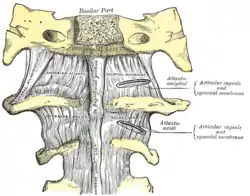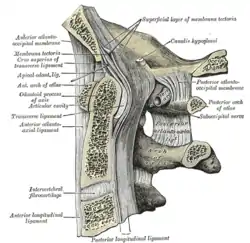Anterior longitudinal ligament
The anterior longitudinal ligament is a ligament that runs down the anterior surface of the spine. It traverses all of the vertebral bodies and intervertebral discs on their ventral side. It may be partially cut to treat certain abnormal curvatures in the vertebral column, such as kyphosis.
| Anterior longitudinal ligament | |
|---|---|
 Median sagittal section of two lumbar vertebræ and their ligaments. (Anterior longitudinal ligament runs vertically at center left.) | |
 Anterior atlantoöccipital membrane and atlantoaxial ligament. (Anterior longitudinal ligament runs vertically at bottom center.) | |
| Details | |
| System | skeletal |
| From | inferior basilar portion of occipital bone |
| To | sacrum |
| Identifiers | |
| Latin | ligamentum longitudinale anterius |
| TA98 | A03.2.01.007 |
| TA2 | 1679 |
| FMA | 31893 |
| Anatomical terminology | |
Structure
The anterior longitudinal ligament runs down the vertebral bodies and intervertebral discs of all of the vertebrae on their ventral side.[1][2] The ligament is thick and slightly more narrow over the vertebral bodies and thinner but slightly wider over the intervertebral discs.[1] This effect is much less pronounced than that seen in the posterior longitudinal ligament. It tends to be narrower and thicker around thoracic vertebrae, but wider and thinner around cervical vertebrae and lumbar vertebrae.[1]
The anterior longitudinal ligament has three layers: superficial, intermediate and deep. The superficial layer traverses 3 – 4 vertebrae, the intermediate layer covers 2 – 3 and the deep layer is only between individual vertebrae.
Clinical significance
The anterior longitudinal ligament may become calcified, causing back pain.[3]
Surgical release
The anterior longitudinal ligament may be "released", or partially cut, between two adjacent vertebrae.[4] This may be done to treat abnormal curvature in the vertebral column, such as kyphosis.[4] Osteoporosis, some infections, and past back surgery may prevent this surgery.[4]
Additional images
 E:Anterior longitudinal ligament
E:Anterior longitudinal ligament Median sagittal section through the occipital bone and first three cervical vertebræ.
Median sagittal section through the occipital bone and first three cervical vertebræ. Costovertebral articulations. Anterior view.
Costovertebral articulations. Anterior view.
References
- Kayalioglu, Gulgun (2009). "3 - The Vertebral Column and Spinal Meninges". The spinal cord : a Christopher and Dana Reeve Foundation text and atlas (1st ed.). Amsterdam: Elsevier / Academic Press. pp. 17–36. doi:10.1016/B978-0-12-374247-6.50007-9. ISBN 978-0-08-092138-9. OCLC 500570905.
- Walker, Matthew T.; Spitzer, Eric; Veeramani, Murugusundaram; Russell, Eric J. (2005). "8 - Anatomy, Imaging, and Common Pain-Generating Degenerative Pathologies of the Spine". Essentials of pain medicine and regional anesthesia (2nd ed.). Philadelphia: Elsevier / Churchill Livingstone. pp. 50–79. doi:10.1016/B978-0-443-06651-1.50012-5. ISBN 978-0-7020-3602-6. OCLC 324998252.
- Giles, Lynton G. F. (2009). "Case 92 - Post-traumatic anterior longitudinal ligament calcification". 100 challenging spinal pain syndrome cases (2nd ed.). Edinburgh: Elsevier / Churchill Livingstone. pp. 425–427. doi:10.1016/B978-0-443-06716-7.00092-X. ISBN 978-0-7020-4271-3. OCLC 460883276.
- Sardar, Zeeshan M.; Baron, Eli M.; Davis, Timothy; Anand, Neel (2018). "Procedure 41 - The Transpsoas Approach for Thoracolumbar Interbody Fusion". Operative Techniques: Spine surgery (3rd ed.). Philadelphia: Elsevier. pp. 358–370. doi:10.1016/B978-0-323-40066-4.00041-2. ISBN 978-0-323-48391-9. OCLC 964627490.
External links
- Atlas image: back_bone25 at the University of Michigan Health System - "Vertebral Column, Dissection, Anterior & Posterior Views"
- lesson7 at The Anatomy Lesson by Wesley Norman (Georgetown University)
- Diagram at spineuniverse.com